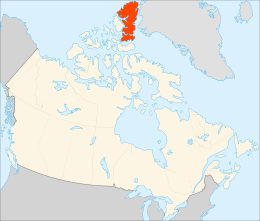Native name: Umingmak Nuna | |
|---|---|
 Tundra in Quttinirpaaq National Park | |
 | |
| Geography | |
| Location | Northern Canada |
| Coordinates | 79°50′N 78°00′W / 79.833°N 78.000°W[1] |
| Archipelago | Queen Elizabeth Islands |
| Area | 196,236 km2 (75,767 sq mi) |
| Area rank | 10th |
| Length | 830 km (516 mi) |
| Width | 645 km (400.8 mi) |
| Highest elevation | 2,616 m (8583 ft) |
| Highest point | Barbeau Peak |
| Administration | |
Canada | |
| Territory | Nunavut |
| Largest settlement | Grise Fiord (pop. 144) |
| Demographics | |
| Population | 144 (2021) |
| Pop. density | 0.00073/km2 (0.00189/sq mi) |
| Additional information | |
| Area code(s) | 867 |
Ellesmere Island (Inuktitut: ᐅᒥᖕᒪᒃ ᓄᓇ, romanized: Umingmak Nuna, lit. 'land of muskoxen'; French: île d'Ellesmere)[2] is Canada's northernmost and third largest island, and the tenth largest in the world. It comprises an area of 196,236 km2 (75,767 sq mi),[3] slightly smaller than Great Britain, and the total length of the island is 830 km (520 mi).
Lying within the Arctic Archipelago, Ellesmere Island is considered part of the Queen Elizabeth Islands. Cape Columbia at 83°06′41″N 069°57′13″W / 83.11139°N 69.95361°W[4] is the most northerly point of land in Canada and one of the most northern points of land on the planet (the most northerly point of land on Earth is the nearby Kaffeklubben Island of Greenland).
The Arctic Cordillera mountain system covers much of Ellesmere Island, making it the most mountainous in the Arctic Archipelago. More than one-fifth of the island is protected as Quttinirpaaq National Park.
In 2021, the population of Ellesmere Island was recorded at 144.[5] There are three settlements: Alert, Eureka, and Grise Fiord. Ellesmere Island is administered as part of the Qikiqtaaluk Region in the Canadian territory of Nunavut.
- ^ "Ellesmere Island". Geographical Names Data Base. Natural Resources Canada.
- ^ Cite error: The named reference
Dickwas invoked but never defined (see the help page). - ^ Cite error: The named reference
areawas invoked but never defined (see the help page). - ^ "Cape Columbia". Geographical Names Data Base. Natural Resources Canada.
- ^ Cite error: The named reference
2021censuswas invoked but never defined (see the help page).

